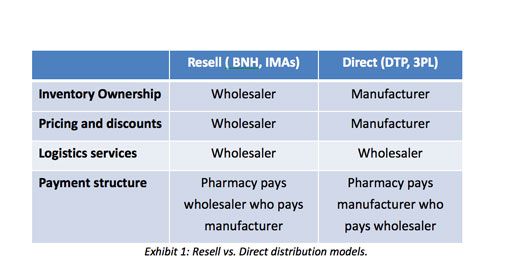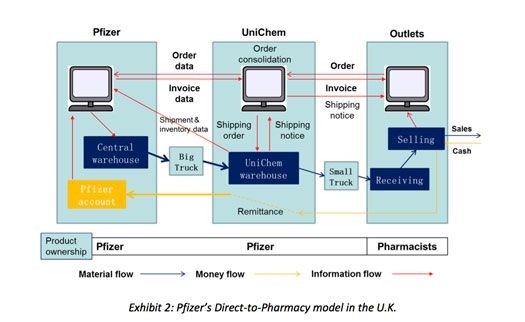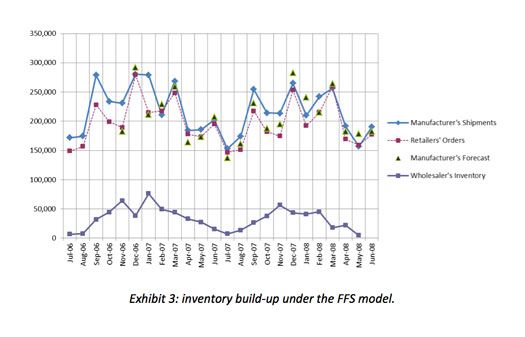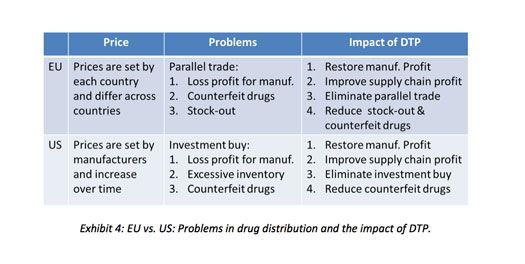Resell vs. Direct Models: US Branded Drug Distribution in the Future
Kathleen Iacocca and Yao Zhao discuss why direct supply chain models can be more sustainable than resell models in the long run and whether they can be implemented in the US.
The US pharmaceutical supply chain has been undergoing a drastic transition from the buy-and-hold model to the fee-for-service model in the last 10 years. Some pharmaceutical manufacturers are experimenting with alternatives, such as non-asset based direct models that shift the ownership of the channel inventory from the wholesaler to the manufacturer. Using data from a leading US pharmaceutical company and its wholesalers, this article provides insights on why direct models can be more sustainable than resell models in the long run and whether they can be implemented in the US.
Introduction
Since 2004, the US pharmaceutical industry has been undergoing a drastic transition from the asset-based resell model, buy-and-hold (BNH), to inventory management agreements (IMAs) and fee-for-service (FFS) models, and more recently to non-asset based direct models such as 3rd party logistics (3PLs) and direct-to-pharmacy (DTP). These models were initiated by drug manufacturers or wholesalers acting in their own best interests. New players, such as 3PLs, are entering this industry and making the future more uncertain.
Here is the issue: the once dominating equilibrium BNH is no longer feasible; the industry fell to a state of chaos with many possibilities emerging. What is the next equilibrium – the resell model of FFS as advocated by wholesalers or the direct model of DTP by manufacturers? Where is the future of branded drug distribution in the US? Although the industry has yet reached consensus, one thing is certain, it has to be a model acceptable to both manufacturers and wholesalers, and it needs to be in the best interests of the patients.
Wholesaling dominates US distribution
Wholesaling is the dominant way to distribute branded drugs in the US. The wholesalers provide valuable logistics services by carrying inventory for 10,000+ SKUs from some 500 manufacturers and delivering mixed load shipments to nearly 140,000 pharmacies on a daily basis, whereas manufacturers only have to ship bulk to at most 300 locations.
The once popular resell model of BNH has led this industry to “a game of arbitrage” by assigning double roles to wholesalers, both as a logistics services provider and a reseller. Due to the price inflation of branded drugs, wholesalers were making about 50% of their profit from investment buying, which is a pervasive practice in this industry where wholesalers and self-warehousing pharmacy chains buy significant volume before price inflations and sell it afterwards. Although manufacturers save money by compensating wholesalers indirectly through investment buying, they lost the profit that they could have made from price inflations. In addition, they generated chaotic price-hedging activities and unregulated secondary markets which led to significant excessive inventory in the channel and the heightened risk of counterfeiting drugs.
Transition and debate
The industry was thrown out of balance in 2004 as SEC accused Bristol-Myers Squibb for “manipulating its inventory of drugs to inflate earnings and meet Wall Street targets.” In the settlement, BMS agreed to limit sales to wholesalers based on demand, which is the origin of the IMAs rolled out by manufacturers to continue compensating wholesalers by inventory appreciation, but at a more controllable level. Suffering losses, the wholesalers made a counter-offer in 2005, the FFS model, to demand a fee from the manufacturers to cover their lost profit previously generated by investment buying. The differences between these agreements are summarized in Exhibit 1.

Unwilling to pay a fee for a previously free service, many manufacturers started to bypass wholesalers by hiring 3PLs. By August 2011, 6 of the top 10 global pharmaceutical manufacturers have outsourced at least part of their US distribution operations to 3PLs. Pfizer went as far as implementing the DTP model in 2007 in the U.K. by hiring a former wholesaler as a logistics intermediary and retaining the ownership of inventory throughout the channel until products reach the pharmacy (Exhibit 2).

The FFS and 3PL models were heavily debated by industry observers, who represented perspectives of different players in the supply chain. To shed light on the future of this industry, we provide an objective comparison of these models based on real-life data and a case study.
Case study and insights
Using data from a leading US pharmaceutical company and its wholesalers, we compare the resell FFS model to the direct DTP model to identify a win-win strategy for this industry. Our case study presents 24 months of data for 3 branded drugs, including wholesalers’ shipments, manufacturers’ shipments and forecasts, drug pricing, and production/inventory cost data for both players.
Our study reveals non-trivial and eye-opening insights:
- Under FFS, wholesalers still have a strong incentive to investment buy. The data in Exhibit 3 shows that they are buying about 2-week to 1-month of inventory for investment purposes.
- Under FFS, wholesalers captured the profits of price inflation by investment buying but at a much higher carrying cost of inventory (specifically, wholesalers’ annual inventory carrying cost is 8% of the wholesale acquisition cost. Manufacturers’ carrying cost is 8% of the production cost, which is 15%-20% of the wholesale acquisition cost). DTP eliminates the incentive of investment buying and minimizes channel inventory. As such, it improves the efficiency of the pharmaceutical supply chain.
- DTP can increase the profitability simultaneously for both manufacturers and wholesalers relative to FFS. Indeed, wholesalers can make more profit by obtaining a higher fee (than FFS) from manufacturers; manufacturers can make more profit by retaining the profits from price inflation despite the higher fee paid to the wholesalers.

US Implementation
Pfizer’s successful implementation of the DTP model in the U.K. sheds lights on its potential and feasibility in the US. Prior to the switch, Pfizer suffered issues such as counterfeit drugs, profit-losing damages and stock-outs from cross-border parallel trade due to geographic price differentials. By partnering with a former wholesaler but in a direct model, Pfizer was able to maintain the same services to pharmacists while ensuring genuine and up-to-date drugs to the patients. Pfizer can even detect illegal market activities at the pharmacy level to prevent profit losses, ensure drug integrity and reduce stock-outs.
The differences between the EU and US and their impact on DTP implementation are summarized in Exhibit 4. On one hand, implementing the DTP in the US can be challenging. First, the US market is larger than that of the U.K. with significant geographic differences, which implies a bigger responsibility and an exposure to higher financial risks and inventory liabilities; a more complex and time consuming process is expected. Second, the pricing structure along the US pharmaceutical supply chain is more complex. Indeed, manufacturers used to provide different prices to retail outlets through the wholesalers. It requires wisdom from manufacturers to legitimately continue such a differentiated price practice in the US under the DTP model.
On the other hand, implementing the direct model in the US with former wholesalers is not more challenging than doing the same with the new entrants - 3PLs. It may be unwise for manufacturers to bypass wholesalers as they are the most experienced and capable players in drug distribution. Pfizer’s experiment shows that the same services can be provided to retail outlets by working with former wholesalers in the direct model. The experiment also shows that manufacturers could utilize wholesalers’ established infrastructure and IT services to manage the customer base and obtain visibility down to the pharmacy level.

Summary
For the best interest of all stakeholders, we believe that the future of the US branded drug distribution lies in the new equilibrium where drug manufacturers and wholesalers work together but in a direct model. This model creates a win-win situation for all stakeholders including manufacturers, wholesalers, and patients and rewards wholesalers on their core competence - logistics services. Wholesalers will be motivated to embark on service innovation and cost efficiency much like 3PLs. Ultimately, the equilibrium better ensures genuine and up-to-date products to the patients. The entrance of 3PLs to this industry serves as a catalyst in the transition to this new equilibrium - wholesalers need to decide between being replaced by 3PLs or becoming a 3PL themselves.
References
Associated Press (2004) “Squibb settles fraud charges.” The Boston Globe 5 Aug.
Basta, N. (2004) “Fee-for-service transition is rolling through pharmaceutical distribution.” Pharmaceutical Business Strategies, 10: 1-2.
BoozAllenHamilton (2004) “The Role of Wholesalers in the US Healthcare Industry.” Healthcare Distribution Management Association.
Cree, N. (2010) “DTP schemes’ pros and cons examined.” The Pharmaceutical Journal, 25 June.
Excel (2001) “Tide has turned: Why do Life Sciences Manufacturers now prefer Outsourcing?” <http://pages.leadlife.com/exel/Repository/Documents/Exel_LifeSciencesOutsourcingWhitePaper_Sept2011_Final.pdf>
Handfield, R. B., V. Dhinagaravel (2005) “Future Trends in Pharmaceutical and Biotech Distribution.” Supply Chain Resource Consortium, North Carolina State University, 4 Nov.
Jack, A. (2007) “Pfizer’s example proves contagious.” Financial Times 14 Dec.
Saul, S. (2005) “Making a Fortune by Wagering that Drug Prices Tend to Rise” New York Times, 26 Jan.
About the Authors
Kathleen Iacocca, Assistant professor, Dept. of Operations & Information Management, University of Scranton, Kathleen.iacocca@scranton.edu and Yao Zhao, Associate professor, Dept. of Supply Chain Management and Marketing Sciences, Rutgers Business ,yaozhao@andromeda.rutgers.edu
Adderall Shortage Drives Shift to Alternative ADHD Medications in Children
January 29th 2025Prescription data between 2017 and 2023 revealed that while Adderall prescription fills decreased following the shortage, many children transitioned to alternative stimulants for attention-deficit/hyperactivity disorder.